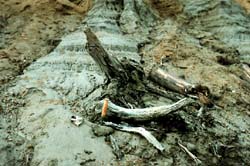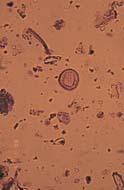
What
are fossils?
Fossils are the remains of ancient plants and animals. Preserved evidence of plants and animals (footprints left in wet clay, preserved wastes, stains left in sediments) are also considered fossils. Fossils occur at natural sites (in caves, in lake sediments, etc), as well as at archaeological sites (places where human activity occurred). They can serve as direct evidence that a specific plant or animal existed in a certain place at a certain time.
How do we know how old a fossil is?
Scientists use radiocarbon dating and relative dating to determine a fossil's age. At Charleston Quarry in eastern Illinois, for example, a glacier overrode a spruce forest. Glacial geologists dated the wood from these trees to learn more about the timing of this event. (To learn more, read Dating.)
Learning from fossils
Organisms that preserve well can provide us with many clues to the past. This is especially true when the fossil has a living counterpart whose environmental preferences are known.
- If the fossil has a living counterpart, modern specimens of the organism can be used to create a 'reference collection.' When a scientist is unsure of the identity of a fossil specimen, he or she may use a reference collection of modern examples to help with the identification. Bones, pollen, seeds, mussel shells, and even whole plants are examples of some of the materials used to create reference collections.
- If the environmental preferences of an organism are known, we can then say something about the kind of environment in which the organism thrived. Was it wetter than today or drier? Colder or warmer? The kind fossils that are found together and the kind of deposit that they are found in also provide clues to past environments.
- Abundance of the fossils is an important factor. If there are enough fossils, statistical methods can be used to interpret data and information from different sites or levels within sites can be compared.
 |
Spruce tree stumps in situ at Charleston Quarry |
Fossils provide information about past environmental conditions.
Fossils that provide indirect (proxy) information on past environmental conditions are called paleo-indicators. Certain types of plants, for example, require specific temperature and moisture conditions in order to thrive. Some kinds of aquatic organisms are sensitive to water chemistry, and can tolerate only narrow ranges of pH and salinity. Ice Age mammals that became extinct at the close of the alst glaciation had specific environmental requirements that were different than those of today. The presence of fossils representative of these organisms can tell us a great deal about the environments of the past; what the climate was like, and what sorts of plants and animals inhabited the landscape.
Some fossils provide a continuous record of environmental change.
Many of the organisms that are preserved in lake sediments have the potential to provide scientists with a continuous record of environmental change through time. This is because these fossils are preserved in sediment that is deposited in new layers every year. The oldest sediments, or the first to be laid down, are at the bottom of the lake muds, and the youngest are at the top. Many small organisms can be preserved within these layers of sediment through time. The changing abundances of these fossils through time can tell us whether a change in the environment or climate was gradual or abrupt.
Some examples of good indicators of ancient environmental conditions are: (click for image):
Diatoms
Ostracodes
Non-marine mollusks
Mosses
Plant parts
Insects
Fossil
pollen
Studying fossil pollen and other fossils helps scientists to learn more about climate change. Based on the evidence these fossils provide, we can find out whether or not climate has changed in the past, and how fast and frequently climate changes occurred. By looking at a long period of climate change in the past, we are able to see patterns that might help us understand climate change today. Many people are interested in this topic; climate change is often mentioned today when unexpected weather occurs.
- If the fossil is abundant; if there are many examples of the fossil available in a particular environment. This allows researchers to draw meaningful conclusions about the presence of an organism. They can use statistical methods to evaluate the data.
- if the fossil is easily identifiable. A fossil is easier to identify if it has a living, present-day representative. The modern organisms can be used to create a reference collection to help in identifying the fossils. A good example is that of a spruce pollen grain. A modern spruce pollen grain can be collected and used to help identify an ancient spruce grain. The same is true of beetles, some bones, etc., modern examples of which can be acquired to create a reference collection.
- if we know the environmental requirements of living representatives of the fossil. Knowing the environmental conditions that allow an organism to thrive enables scientists to deduce the conditions that prevailed when the organism represented by that fossil was alive.
 |
For more information about palynology (the study of fossil pollen), go to: |
|
| Oak pollen. |
|
|
Copyright © 2000 Illinois State Museum